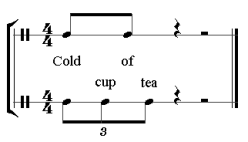Polyrhythm, which exists when two or more “conflicting” rhythms sound simultaneously, creates musical ambiguity.
I can illustrate polyrhythm with a simple example of playing two against three. We begin by dividing a unit of time into six equal parts, then organizing the divisions into three-beat and two-beat groups:
1 . . . . . (One unit of time into six divisions)
1 . 2 . 3 . (Three beats. Count: 1 & 2 & 3 &)
1 . . 2 . . (Two beats. Count: 1 & a 2 & a)
Play all three together, perhaps by tapping the single division with your feet, the triple division with your right hand, and the duple division with your left hand. Voila, polyrhythm.
For those who read music, here is a notated example of two against three.
Finally, here is an excellent “how to play Africa polyrhythms” video example: CK LADZEKPO – Polyrhythm from Ghana, West Africa
Polyrhythm is fundamental to the music of West Africa. Similar techniques are found all over the world. Johannes Brahms often used polyrhythm (although he would not have called it that). 20th century Western art music is full of instances.
An interesting example of rhythmic displacement is found in Kecak, a music genre from Bali, Indonesia. You will notice in the example below that each line has the same rhythmic sequence, but because each sequence falls in a different place against the main beat (in red bold), one gets the impression of hearing altogether different rhythms.
(The letter “C” stands for the vocalization “chak.” The symbol “.” represents silence.)
C. C C . C C . C .C C . C C .
. C . C C . C C . C . C C . C C
C . C . C C . C C. C . C C . C
For many of my college students, the mental and emotional vitality of rhythmic ambiguity becomes immediately accessible if I change mediums and show them a bi-stable visual image, one such as the Necker Cube.
In the above image, either corner A or corner B can be visualized as projecting forward, making two perspectives from which to conceive the cube. (There is much more to notice. When looking at the image carefully, one will discover that all six cube faces can be seen as facing toward the viewer [three from each perspective]. Also, in each perspective seven corners are “visible.” And of course, when moving from conceptualizing corner A being forward to corner B being forward there is a disconcerting liminal [a transitional or neither/nor] perspective. There are many more ways to visualize this image.)
What does all this have to do with stroke rehabilitation? I will discuss two important ideas. First, conceptualizing and resolving ambiguity requires a certain amount of mental focus. Second, working to understand something from multiple perspectives is good practice for anyone, and especially for stroke patients.
After my own stroke, I had difficulty maintaining focus long enough to resolve ambiguity, whether it was a block of Scrabble letters, a Sudoku puzzle, or even something so “simple” as interpreting the position of hands on a clock face. (A good focusing exercise is holding a single perspective on the Necker cube. While attempting this exercise, notice the techniques employed to hold the cube in place.)
After my stroke I also had difficulty juggling multiple perspectives. Particularly distressing was the fact that I often did not “get” witticisms. Words seemed to carry blunt meanings rather than offer shades of nuance and possibility. In trying to mitigate the problem, I worked on conceptualizing ambiguity.
In today’s post I expected to discuss some of the melodic/tonal exercises I use to create, explore, develop, and resolve ambiguity. But since this post is already getting a bit long, I will wait until the next entry.


